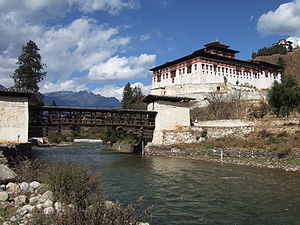
Rinpung Dzong
Encyclopedia
Rinpung Dzong is a large Drukpa Kagyu Buddhist monastery and fortress in Paro District
in Bhutan
. It houses the district Monastic Body and government administrative offices of Paro Dzongkhag.
In the seventeenth century, his descendants, the lords of Hungrel, offered this fortress to the Drukpa heirarch Shabdrung Ngawang Namgyal, in recognition of his religious and temporal authority. In 1644 the Shabdrung dismantled the existing Dzong and laid the foundations of a new Dzong. In 1646 the Dzong was reconsecrated and established as the administrative and monastic centre of the western region and it became known as Rinpung Dzong.
Some scenes in the 1993 film Little Buddha
were filmed in this Dzong.
 Inside Rinpung Dzong are fourteen shrines and chapels:
Inside Rinpung Dzong are fourteen shrines and chapels:
Outside the main Dzong there is the Deyangkha Lhakhang.
On the hill above Rinpung Dzong is a seven storied the watchtower fortress or Ta Dzong built in 1649. In 1968 this was established as the home of the National Museum of Bhutan
.
Just below Rinpung Dzong is a traditional covered cantilever bridge
.
). On this occasion, holy images are taken in a procession. This is followed by a series of traditional mask dances conveying religious stories which are performed by monks for several days.
Before the break of dawn on the morning of the fifteenth day, a great sacred Tongdrol banner depicting the Eight Manifestations of Guru Rinpoche (Padmasambhava)is displayed for the public in the early morning hours, to keep to the tradition of not allowing sunlight to fall on it..
Paro District
Paro District is the name of a district , valley, river and town in Bhutan. It is one of the most historic valleys in Bhutan. Both trade goods and invading Tibetans came over the pass at the head of the valley, giving Paro the closest cultural connection with Tibet of any Bhutanese district...
in Bhutan
Bhutan
Bhutan , officially the Kingdom of Bhutan, is a landlocked state in South Asia, located at the eastern end of the Himalayas and bordered to the south, east and west by the Republic of India and to the north by the People's Republic of China...
. It houses the district Monastic Body and government administrative offices of Paro Dzongkhag.
History
In the fifteenth century local people offered the crag of Hungrel at Paro to Lama Drung Drung Gyal, a descendant of Pajo Drugom Zhigpo. Drung Drung Gyal built a small temple there and later a five storied Dzong or fortress which was known as Hungrel Dzong.In the seventeenth century, his descendants, the lords of Hungrel, offered this fortress to the Drukpa heirarch Shabdrung Ngawang Namgyal, in recognition of his religious and temporal authority. In 1644 the Shabdrung dismantled the existing Dzong and laid the foundations of a new Dzong. In 1646 the Dzong was reconsecrated and established as the administrative and monastic centre of the western region and it became known as Rinpung Dzong.
Some scenes in the 1993 film Little Buddha
Little Buddha
Little Buddha is a 1994 feature film by Italian director Bernardo Bertolucci, starring Bridget Fonda and Keanu Reeves. Made by Bertolucci's regular partner, British producer Jeremy Thomas, it marked the team's return to the East after The Last Emperor....
were filmed in this Dzong.
Shrines and Chapels

- Kungarwa
- Dukhang - or monks assembly hall
- Tseden Chöten (sandlwood stupa) shrine
- Protector's shrine
- Temple of the Guru's Eight Manifistations (གུ་རུ་མཚན་རྒྱད་ལྷ་ཁང)
- Chapel of the head Lama
- Chapel of Amitayus
- The Clear Crystal Shrine
- Chapel of the Eleven-faced Avalokiteshvara
- Apartments of the Abbot
- Chapel of Akshobya Buddha
- Temple of the Treasure Revealer
- Apartments of the King (Gyalpo'i Zimchung)
- Temple of the Bursar
Outside the main Dzong there is the Deyangkha Lhakhang.
On the hill above Rinpung Dzong is a seven storied the watchtower fortress or Ta Dzong built in 1649. In 1968 this was established as the home of the National Museum of Bhutan
National Museum of Bhutan
National Museum of Bhutan is a cultural museum in the town of Paro in western Bhutan. Established in 1968, in the renovated ancient Ta-dzong building, above Rinpung Dzong under the command of His Majesty, the King Jigme Dorji Wangchuck, the third hereditary Monarch of Bhutan...
.
Just below Rinpung Dzong is a traditional covered cantilever bridge
Cantilever bridge
A cantilever bridge is a bridge built using cantilevers, structures that project horizontally into space, supported on only one end. For small footbridges, the cantilevers may be simple beams; however, large cantilever bridges designed to handle road or rail traffic use trusses built from...
.
Festivals
A great annual festival or tsechu is held at Rinpung Dzong from the eleventh to the fifteenth day of the second month of the traditional Bhutanese lunar calendar (usually in March or April of the Gregorian calendarGregorian calendar
The Gregorian calendar, also known as the Western calendar, or Christian calendar, is the internationally accepted civil calendar. It was introduced by Pope Gregory XIII, after whom the calendar was named, by a decree signed on 24 February 1582, a papal bull known by its opening words Inter...
). On this occasion, holy images are taken in a procession. This is followed by a series of traditional mask dances conveying religious stories which are performed by monks for several days.
Before the break of dawn on the morning of the fifteenth day, a great sacred Tongdrol banner depicting the Eight Manifestations of Guru Rinpoche (Padmasambhava)is displayed for the public in the early morning hours, to keep to the tradition of not allowing sunlight to fall on it..

